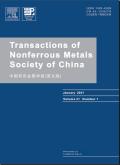增加预变形的 T8 时效铝-铜-锂合金的强化机制
IF 4.7
1区 材料科学
Q1 METALLURGY & METALLURGICAL ENGINEERING
Transactions of Nonferrous Metals Society of China
Pub Date : 2024-10-01
DOI:10.1016/S1003-6326(24)66599-4
引用次数: 0
摘要
研究了预变形增加(0-15%)后 T8 时效铝-铜-锂合金的微观结构演变和力学性能,揭示了微观结构与强度的关系以及内在强化机制。结果表明,增加预变形量可显著提高合金的强度,但会降低其延展性。预变形引入的位错有效地抑制了吉尼尔-普雷斯顿(GP)区的形成,并为 T1 沉淀提供了更多的成核点。这导致预变形程度较高的样品中的 T1 沉淀更密集、更细小。同时,T1析出物析出的增强和 GP 区形成的抑制导致了 θ′析出物数量和尺寸的减小。对不同强化机制的强度贡献的定量描述表明,T1 和 θ′析出物的强化贡献随预变形的增大而减小。T1 析出物直径的减小是其强化效果减弱的主要原因。因此,T8 时效铝-铜-锂合金强度的提高主要归因于预变形水平的提高产生了更强的应变硬化。本文章由计算机程序翻译,如有差异,请以英文原文为准。
Strengthening mechanism of T8-aged Al−Cu−Li alloy with increased pre-deformation
The microstructure evolution and mechanical properties of a T8-aged Al−Cu−Li alloy with increased pre-deformation (0−15%) were investigated, revealing the microstructure−strength relationship and the intrinsic strengthening mechanism. The results show that increasing the pre-deformation levels remarkably improves the strength of the alloy but deteriorates its ductility. Dislocations introduced by pre-deformation effectively suppress the formation of Guinier-Preston (GP) zones and provide more nucleation sites for T1 precipitates. This leads to more intensive and finer T1 precipitates in the samples with higher pre-deformation levels. Simultaneously, the enhanced precipitation of T1 precipitates and inhibited formation of GP zones cause the decreases in number and sizes of θ′ precipitates. The quantitative descriptions of the strength contributions from different strengthening mechanisms reveal that strengthening contributions from T1 and θ′ precipitates decrease with increasing pre-deformation. The reduced diameters of T1 precipitates are primarily responsible for their weakened strengthening effects. Therefore, the improved strength of the T8-aged Al−Cu−Li alloy is mainly attributed to the stronger strain hardening from the increased pre-deformation levels.
求助全文
通过发布文献求助,成功后即可免费获取论文全文。
去求助
来源期刊
CiteScore
7.40
自引率
17.80%
发文量
8456
审稿时长
3.6 months
期刊介绍:
The Transactions of Nonferrous Metals Society of China (Trans. Nonferrous Met. Soc. China), founded in 1991 and sponsored by The Nonferrous Metals Society of China, is published monthly now and mainly contains reports of original research which reflect the new progresses in the field of nonferrous metals science and technology, including mineral processing, extraction metallurgy, metallic materials and heat treatments, metal working, physical metallurgy, powder metallurgy, with the emphasis on fundamental science. It is the unique preeminent publication in English for scientists, engineers, under/post-graduates on the field of nonferrous metals industry. This journal is covered by many famous abstract/index systems and databases such as SCI Expanded, Ei Compendex Plus, INSPEC, CA, METADEX, AJ and JICST.

 求助内容:
求助内容: 应助结果提醒方式:
应助结果提醒方式:


